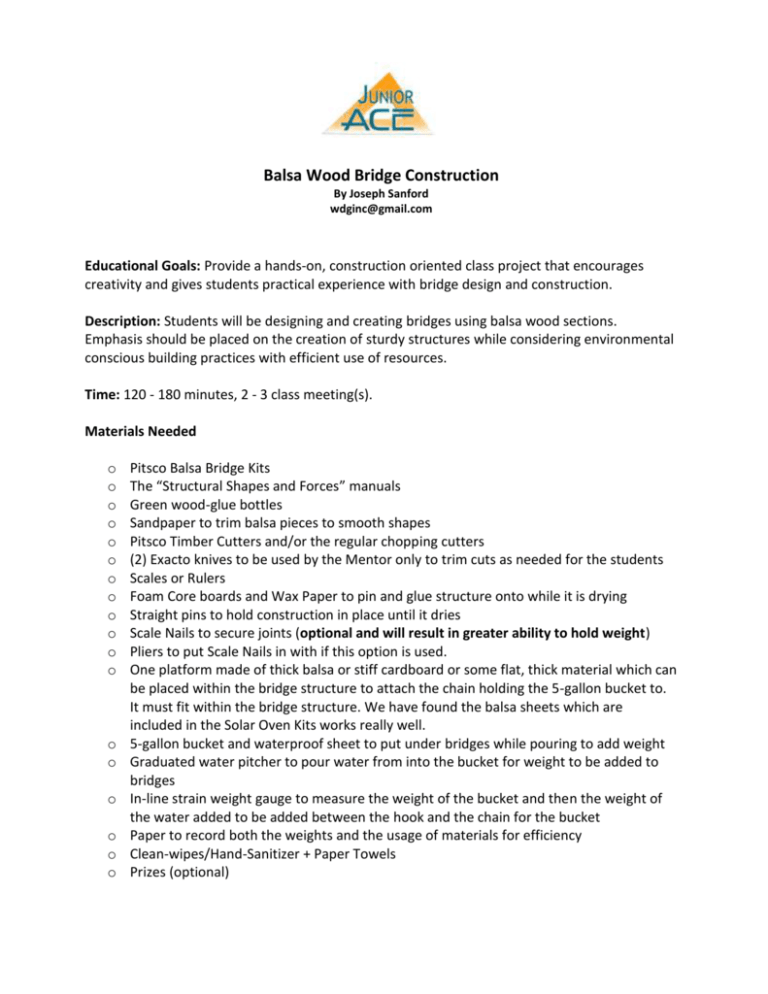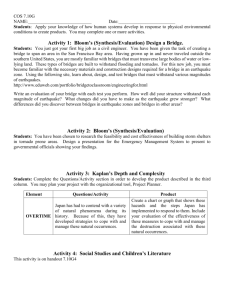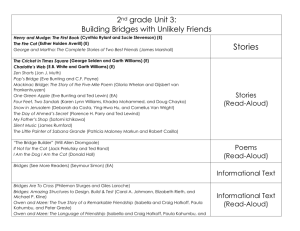Balsa Bridge Construction
advertisement

Balsa Wood Bridge Construction By Joseph Sanford wdginc@gmail.com Educational Goals: Provide a hands-on, construction oriented class project that encourages creativity and gives students practical experience with bridge design and construction. Description: Students will be designing and creating bridges using balsa wood sections. Emphasis should be placed on the creation of sturdy structures while considering environmental conscious building practices with efficient use of resources. Time: 120 - 180 minutes, 2 - 3 class meeting(s). Materials Needed o o o o o o o o o o o o o o o o o o Pitsco Balsa Bridge Kits The “Structural Shapes and Forces” manuals Green wood-glue bottles Sandpaper to trim balsa pieces to smooth shapes Pitsco Timber Cutters and/or the regular chopping cutters (2) Exacto knives to be used by the Mentor only to trim cuts as needed for the students Scales or Rulers Foam Core boards and Wax Paper to pin and glue structure onto while it is drying Straight pins to hold construction in place until it dries Scale Nails to secure joints (optional and will result in greater ability to hold weight) Pliers to put Scale Nails in with if this option is used. One platform made of thick balsa or stiff cardboard or some flat, thick material which can be placed within the bridge structure to attach the chain holding the 5-gallon bucket to. It must fit within the bridge structure. We have found the balsa sheets which are included in the Solar Oven Kits works really well. 5-gallon bucket and waterproof sheet to put under bridges while pouring to add weight Graduated water pitcher to pour water from into the bucket for weight to be added to bridges In-line strain weight gauge to measure the weight of the bucket and then the weight of the water added to be added between the hook and the chain for the bucket Paper to record both the weights and the usage of materials for efficiency Clean-wipes/Hand-Sanitizer + Paper Towels Prizes (optional) Directions BEFORE CLASS Practice building yourself before teaching this class to ensure that you can help students with their questions. Be aware that there may be drastically different results between students in the class (some will build bridges that barely stand on their own. Others will be able to construct bridges able to withstand several ounces of weight). Preparing Ice-Breakers is recommended if the class has not socialized amongst themselves very much thus far. This lesson plan involves students being very hands-on and if the class is too large, students may need to form groups. Ensuring that they will all work together happily is important. DURING CLASS This approach is based on the lesson which involves resource management. It involves careful use of resources above all else, to introduce the concept of good stewardship and efficient design, defined as the bridge design which can hold the most weight using the least materials. The "Limited Resources" Approach. i. This lesson is recommended for smaller class settings, but you can break larger classes into smaller groups just as well. It allows you to be more hands-on with individual students or groups of students as they construct the bridges. ii. You will need to pick a minimum weight you want the bridges to work with. Instruct the students that they will be designing a bridge that must be able to withstand this minimum weight. I've found that approximately half a pound is an effective choice. This number can be altered according to various factors. In my experience, the weight limit is very attainable, but be ready to manipulate this variable to ensure all students are content. iii. Have the students design a bridge that crosses a theoretical river of 10" 12” wide. Some students may be able to build bridges that are longer while still able to withstand the minimum weight. iv. The students are given the same quantity of materials at the start. If/When they run out they must come to you for more. Give them another batch of balsa to continue on with. Record this amount under their team name. The team that wins will be the team that can build a bridge able to withstand the greatest weight using the least material. This shows efficiency of design and construction. v. Towards the end of the final session, have a "weigh-in ceremony" where you have all the students watch as you measure the capacity of the bridges. Expect some well-built bridges to actually explode when they break, meaning they fail all at once under incredible tension. Others which are less well-built, will simply crumble in stages. Mentor is to put the 5-gallon plastic bucket on the chain with the strain gauge attached over the plastic sheet below the bridge, then pour measured water from the graduated pitcher into the bucket slowly. Stop after a bit to measure the water poured, or you can pour until the bridge breaks, keeping track of how much water has been poured. Water weighs 8 pounds per gallon, which is one ounce of weight per one ounce of liquid. Thus, if the bridge breaks at 34 ounces of water, that equates to 34 ounces of weight, or 2 pounds and 2 ounces. Record the amounts under the team names on the papers next to the materials used so you know how much each bridge could hold and how much material they used, to get the most efficient bridge, which will be the grand prize winner. vi. Have a Ceremony after all bridges are finished with the testing. Give a prize to the overall winner or have categories, such as best looking design, longest bridge, strongest bridge, etc. and give prizes for each. vii. Once the "ceremony" is over, have the students clean-up their areas and throw all trash away. They can keep their bridges if they want to take them home. viii. Don’t forget to take pictures (get those releases in hand, folks!) of the kids with their bridges before the testing and again after to show the handiwork and the results of the testing. Take photos of the winners in each category as well. Use these for Jr. ACE marketing and give copies to the kids by email! Additional Resources Topics to Discuss o Simple, effective construction strategies. Refer to the “Structural Shapes and Forces” manuals for teaching aid on the different structural shapes, the forces which act on them, and the different types of bridges they can build. o Budgeting of resources o Green Building practices (especially how to plan the cuts to minimize waste) o Situations where renewable resources may be substitutes for traditional resources. o Reduced overhead does not necessarily equate to reduced quality of products o Facts pertaining to construction industry. Mentor Notes It is advisable that instructors get the needed materials beforehand and run through this session themselves several times to ensure that they are aware of the challenges they are asking of their students. Ensure that you have a storage space to put existing structures between class sessions. Store the structures in a stable and dry location. All instructors are encouraged to use the Construction Manual included in the Pitsco Balsa Bridge Kit to explain concepts in concert with the Structural Shapes and Forces Manual, before starting, to ensure the students have some idea of how structures work and how to design their bridges effectively. Mentor will have to give hands-on advice during construction to make sure students understand these concepts and see the results of their joint design, which is where the bridges will be weakest.






